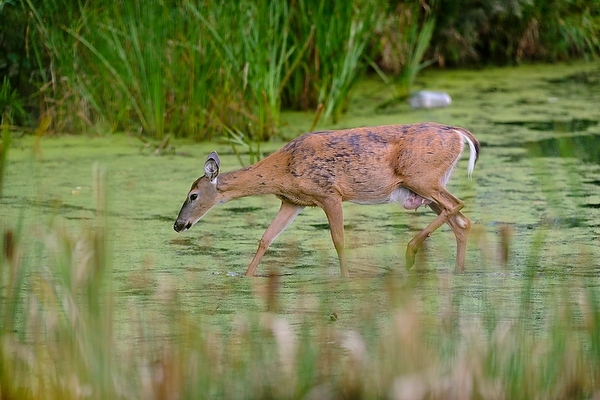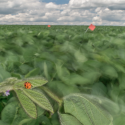Ecologist/hunter talks deer, plants, hunters and balance

Donald Waller, professor of botany at the University of Wisconsin–Madison and a national expert on the impact of deer over-population on ecosystems, at his deer hunting stand in the driftless area of Wisconsin in fall 2014.
Photo: Ken Cameron, UW–Madison
UW-Madison Professor of Botany Donald Waller is a pioneer in exploring the impact of deer in natural habitats. For more than 20 years, Waller — who counts himself among the state’s deer hunters — has led research on the economic, health and environmental impacts of deer, including:
- The health costs of Lyme disease;
- Auto accidents;
- The spread of chronic wasting disease;
- Failures of tree regeneration;
- Denudation of forest understories and changes in forest structure; and
- Loss of biodiversity and accompanying impacts, including serious declines in forest animals and birds that nest on the ground or in the lower branches.
In an interview in advance of gun deer season in Wisconsin, Waller talks about deer, plants, hunters and balance.
Why do you hunt?
Donald Waller: First, deer are overabundant relative to the long-term carrying capacity of their habitat. In the absence of other predators, human predators play a crucial ecological role. I want to be part of that. It’s also an excuse to be outside, it’s challenging, demands skill, and is a way of getting high-quality food from the environment. I also want to understand hunters and hunting culture. About 600,000 hunters hit the Wisconsin woods each year trying to get a deer, and they drive a lot of decisions on deer management. Being a hunter myself helps me to understand their motivations.
There’s been a long debate in the state about how many deer we “should” have. Why do you favor a smaller herd?
Waller: A 100-pound deer needs to eat five to eight pounds of forage per day. With a herd of more than 1 million deer, that’s a lot of food! Deer are not giraffes — they take all their food from the forest understory. The herd doubled from the ’80s to the 2000s. Thanks to a lot of research, most scientists and professional deer managers now accept that deer are having substantial, long-lasting impacts on tree regeneration and forest diversity.
I began my research into this by focusing on regeneration of northern white cedar and eastern hemlock. We counted seedlings and saplings and built a lot of fenced “exclosures” to keep deer out of certain places. We found very little natural regeneration of these species and noted as well that deer are affecting white pine, northern red oak and yellow birch.
Are hunters uniform in desiring a high deer population?
Waller: No. A vocal group of hunters has applied political pressure to sustain high deer density, but there are other hunters who accept their role as predators, and appreciate the need for better habitat. The Quality Deer Management Association in Louisiana has argued that, after a hard winter, we should keep the hunt up and the herd down. They are concerned with ecological values, and with getting trophy animals — which come from habitat without an unreasonable number of deer. So hunters are not all the same.
Doesn’t the severe winter just passed require us to keep tight restrictions on hunting?
Waller: No, we should use this as a time to bring the herd back in line with our habitat. The DNR has closed hunting for antlerless deer in 19 northern counties on the grounds that we need to build up the herd. Maybe the high mortality earlier this year was because the deer were hungry and went into winter without enough fat. We have not monitored the health of deer, so we don’t know.
This isn’t just a problem in Wisconsin, is it?
Waller: My concern is that deer here are approaching what they have in parts of Pennsylvania, where the deer have eaten themselves out of house and home. I’ve consulted with the state: trees have stopped regenerating, the understory has mostly ferns and sedges, and the deer herd is at risk of starvation. Hunters here got used to high deer numbers through the ’90s and early 2000s, but these numbers can’t be sustained. Pennsylvania forests show us where not to go. The damage deer do now takes decades to repair.
Is this just about the plants?
Waller: Not really. Clearing out the forest understory also affects many animals. In British Columbia, island studies show that birds that rely on the forest floor and understory are crashing. These natural experiments suggest that deer impacts cascade through the forest, perhaps affecting bird populations through much of North America.
Do you see a path forward?
Waller: It’s my feeling that our state DNR could do a better job of educating hunters. During hunter education, can’t we spend even one hour to discuss the ecology of deer and how hunters act as predators on deer? It’s a wasted opportunity. I’d also extend this to include high school students. With their science teachers, they could build fences in school forests, plant tree seedlings and wildflowers, and then measure just what vegetation the deer are eating. This could be a great citizen science project. It wouldn’t cost much but would supply valuable data to inform hunters, game managers and the public about whether deer densities are too high or too low. With buy-in from all three groups, we could manage deer better and avoid damaging our forests in ways that take many years to reverse.



